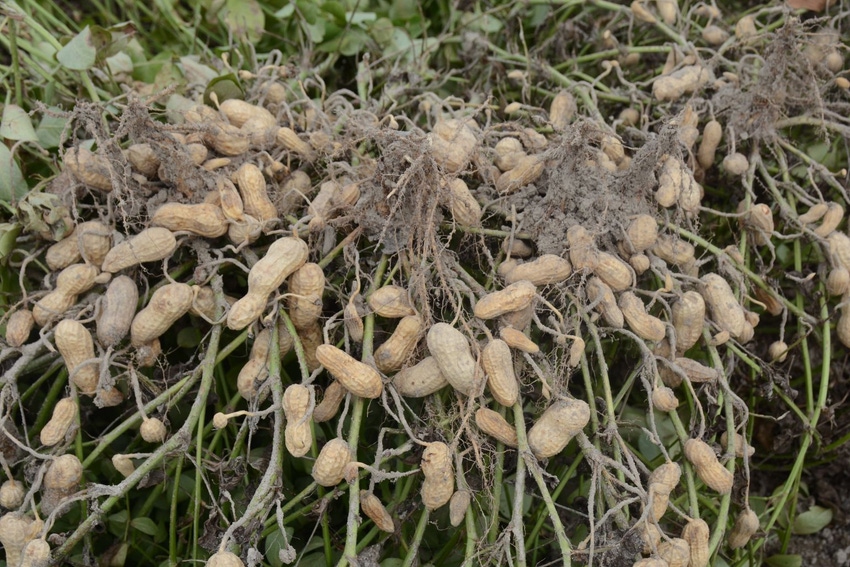
Editor's Note: The U.S. peanut industry is expressing relief that the impact of Hurricane Irma was not as severe to the crop as expected. When this article was originally prepared, there was concern that Irma could severely impact a projected record peanut crop. in comments following the storm, Dell Cotton, manager of the Peanut Growers Cooperative Marketing Association in Franklin, Va. and N.C. State Extension Peanut Specialist said the peanut crop in the Carolinas and Virginia is fine following the storm.
"North Carolina is mostly okay," Jordan explained in an email. "Most peanuts are at least seven days away from digging so if we dry out we should be okay. Many fields are 2 weeks away. Certainly disease is exploding, especially in South Carolina but also North Carolina. But we still have a solid chance at a big crop. In my experience it is the second storm that is the killer, especially when the first storm is in late August or early September."
Cotton said the Virginia crop still looks excellent. "We pretty much escaped the storm up here and feel very fortunate to have done so. "With little rain from now on we have the potential for certainly a two ton crop in Virginia . Right now we need heat to finish it out as many fields show two plus weeks to go," he noted in an email.
At this year’s field day held Sept. 8 at the Peanut Belt Research Station in Lewiston-Woodville, N.C., concern about Hurricane Irma was first and foremost on the agenda because both the Southeast and the United States as a whole are on track to produce a record peanut crop.
In comments at the field day, Dell Cotton, manager of the Peanut Growers Cooperative Marketing Association in Franklin, Va., said the U.S. is projected to produce 3.7 million tons of peanuts this year, which would be the biggest U.S. crop ever. Demand is estimated at 3.1 million tons, 600,000 tons less than supply.
“This level of production could easily lead to once again some peanuts being forfeited. We haven’t seen that tin a couple of years. But if we make the crop that’s expected that could happen again,” Cotton said at the field day. “Anytime that happens that tends to affect next year’s contract price. The last time this happen China stepped in and bought a lot of those peanuts that had been forfeited. Let’s hope if we have the forfeitures that China would step in and buy them again but that depends on price or whether they need them or not. Time will tell.”
Cotton said Hurricane Irma is still the big question mark when it comes to the peanut crop in the Southeast. The Southeast is still the largest peanut producing region in the U.S. and was on track to produce its largest crop ever before the storm. There is concern that Hurricane Irma will severely impact the peanut crop in Georgia, Florida and Alabama.
U.S. peanut acreage in 2017 is pegged at 1,815,000 acres, the highest in recent memory, Cotton said.
The Southeast -Georgia, Florida, Alabama and Mississippi - has 1,275,000 acres planted to peanuts this year, 15 percent above last year and the biggest acreage in recent memory. Virginia, North Carolina and South Carolina have 262,000 acres planted to peanuts this year, 13 percent above 2016.
The Southwest - Oklahoma, Texas and Arkansas - have 313,000 acres planted to peanuts this year which is less than 2016, but Cotton noted that quite a few acres planted in Texas last year were never harvested so acres planted this year in the Southwest are actually 25 percent more than were harvested in 2016.
Prior to Hurricane Irma, the U.S peanut crop was in excellent shape. In fact, Cotton noted that half of the peanut producing states were projected to average a yield of two tons of peanuts to the acre. “The national average is expected to be around 4,200 pounds per acre, led by Georgia,” Cotton said. “Georgia is estimated to make 4,600 pounds to the acre on 807,000 acres."
David Jordan, North Carolina State University Extension peanut specialist, said the timing of Irma is important. He said a hurricane in the second week of September is better than a storm hitting peanuts in the third or fourth week of September.
“We’ve had times when a storm comes in and dumps a lot of rain and then it dries up and we then have perfect conditions. That’s where I hope we end up. We do have a really good crop. I just hope we can get it out and then we’ll be in good shape.”
Jordan is forecasting an average statewide yield of two tons per acre in North Carolina this year. “It just depends on what happens in the next two weeks in terms of whether we get two tons or not,” he said.
About the Author(s)
You May Also Like






